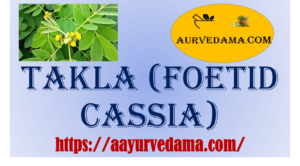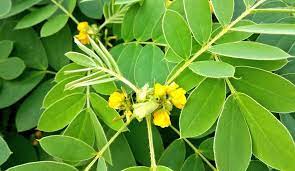Takla (Foetid cassia)
A small, leguminous shrub. Takla (Foetid cassia) is a perennial plant belonging to the family Fabaceae and its scientific name is Sena tora or Cassia tora. It is native to Asia and is found in all tropical countries. It is widely seen in the states of Uttar Pradesh and Madhya Pradesh in India. Also, it grows everywhere as a roadside weed in fallow places during rainy season. This plant is referred to in its English name as phytid (stink) because of its unpleasant odor.

Takla 1 m. Grows up to. Leaves compound, alternate, pinnate and smooth. 10 cm. are long. Each leaf has four pairs of leaflets. The lower pair of leaflets is smaller and the terminal pair is larger. The flowers are small and yellow and appear in the axils of the leaves. Flowers have five petals, one of which is divided and the other four are intact. Pods are long, flexible and thin. It contains 25–30 seeds. Flowers come in monsoon and fruits in winter.
Must read – Liquorice
The young ones of the pond are the vegetables of the young. Leaves are mild laxative, anthelmintic. The roasted seeds are powdered and drunk as coffee. The seeds are ground up and applied to naita, dermatitis and other skin diseases.
The plant which is called Rantakala is also a plant of Sena genus. Its classical name is Sena Sophera. 2.5–3.5 m. This tall evergreen shrub is found in tropical regions and in India, generally in barren and barren places during the rainy season. It is perennial or perennial and its general symptoms and uses are similar to those of Takla .

Medicinal Uses of Takla –
– The leaves of takla contain laxative and red color. This plant contains ’emodin’ glucoside. Takla is anulomic, its action is on the skin. Takla is given in all types of skin diseases. It is especially useful if the skin is rough. Leafy vegetables are given in dermatitis and the seeds are split and removed. The practice is to use the seeds from lemon juice.
Read Also – Nutmeg
– Pishti made from roots and lemon juice is used for gajakarna. Leaves and seeds contain ‘chrysogenic acid’, valuable in dermatitis.
– Leaves are anthelmintic and mild laxative.
– Extract of leaves is directed to fever in children during teething.

– In gall, heart disease, breath, cough, leaf juice is given with honey.
This article is for information only. Consult your doctor for proper treatment.
Source – Marathi Vishwakosh
Read More –